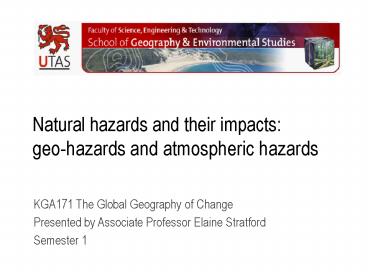Natural hazards and their impacts: geo-hazards and atmospheric hazards - PowerPoint PPT Presentation
1 / 37
Title:
Natural hazards and their impacts: geo-hazards and atmospheric hazards
Description:
Natural hazards and their impacts: geo-hazards and atmospheric hazards KGA171 The Global Geography of Change Presented by Associate Professor Elaine Stratford – PowerPoint PPT presentation
Number of Views:234
Avg rating:3.0/5.0
Title: Natural hazards and their impacts: geo-hazards and atmospheric hazards
1
Natural hazards and their impacts geo-hazards
and atmospheric hazards
KGA171 The Global Geography of Change Presented
by Associate Professor Elaine Stratford Semester 1
2
Vulnerability
- L vulnerare to wound capable of being wounded
open to attack or damage assailable - Geographical imagination
- Emotional geographies
Peter Monamy, Loss of HMS 'Victory', 4 October
1744
3
Looking back, looking forward
- Part 1
4
Revising Lecture 5.3
- Name and explain Wirths categories of the urban.
- Describe Mumfords understanding of the
relationship between spaces and people. - What are six elements of city life that are seen
as positive? Are these exclusive to the urban? - Describe and exemplify the dynamic relationship
between urbanization and industrialization. - What did Ebenezer Howard mean by the town and
country magnet? - What is a slum? How is the existence of slums a
geographical problem? - Describe and explain the spatial patterns for (a)
urban population as a percentage of total
population and (b) average annual urban growth
rate. - Name and explain the salience of six
characteristics of world or global cities. - Does the prevalence of small cities mean that
sustainable development is more likely than if we
all lived in mega-cities? Justify your answer. - Summarize the main objectives of Chapter 7 of
Agenda 21. - What does William McDonough have to say about
biological and technical nutrients and how might
these relate to sustainable development in urban
spaces?
A Woman Thinking
5
Learning Objectives
- Module 6 Lecture 1
- KGA171
- be able to
- explain why vulnerability is a key emotional
geography among human beings, especially in the
face of natural hazards - name, describe and exemplify a range of natural
hazards - name, describe and explain a range of management
responses to hazards
- demonstrate knowledge of geographical concepts,
earth and social systems and spatial patterns of
change - create and interpret basic maps, graphs and field
data - identify and analyse different viewpoints to
contribute to debates about global development - communicate in reflective and academic writing,
referencing literature when needed
6
Textbook Reading
- Burton, I. Kates, R.W. (1964) The perception of
natural hazards in resource management, Natural
Resources Journal 3(3) pp.412-441. - Cutter, S.L. Finch, C. (2008) Temporal and
spatial changes in social vulnerability to
natural hazards, Proceedings of the National
Academy of Sciences 105(7) pp.2301-6. - Critical reading
- What is the authors purpose?
- What key questions or problems does the author
raise? - What information, data and evidence does the
author present? - What key concepts does the author use to organize
this information, this evidence? - What key conclusions is the author coming to? Are
those conclusions justified? - What are the authors primary assumptions?
- What viewpoints is the author writing from?
- What are the implications of the authors
reasoning? - from Foundation for Critical Thinking
Old Woman Reading a Lectionary, Gerard Dou
7
Types of geo-hazards
- Part 2
8
Geo-hazards in specific environments
- Fluvial environments erosion, sediment
accumulation - Coastal environments storm surges, sea-level
rise, inundation, erosion - Aeolian environments wind erosion, dust storms,
desertification - Periglacial environments avalanches,
thermokarst - Glacial environments glacier outburst floods,
surges - Karst environments sinkhole flooding, hidden
cover collapse
9
Land instability
10
Tsunamis
11
Wind erosion
12
Permafrost
13
(No Transcript)
14
Effects of volcanic activity
15
(No Transcript)
16
Land subsidencedue to groundwater pumping
Broadscale subsidence
17
Karstic sinkholes
18
Atmospheric hazards
- Part 3
19
Atmospheric hazards
Areally-extensive storm activity Tropical cyclones Extra-tropical cyclones Storm surges Localised strong winds Tornadoes Dust storms Other localised winds Lacustrine storms (lakes) Wind and waves Ocean hazards Waves Sea ice Coastal erosion Sea level rise Droughts Short term impacts Longer term impacts Precipitation-induced floods Flash floods Large regional floods Changes caused by floods Other precipitation hazards Thunderstorms and lightning Hail Snowstorms Blizzards Freezing rain Fires and vegetation Bushfires
Source Bryant E.A. 1991 Natural Hazards.
Cambridge University Press, Cambridge.
20
(No Transcript)
21
Interactions are complex
Source Bryant, E. (1991) Natural Hazards.
Cambridge Cambridge University Press
22
Storm surges
Storm surge, attributed to Hurricane Eloise
23
Strong winds
Darwin, Australia after Cyclone Tracy
24
Flooding
25
Electrical storms
26
Winter storms
http//www.kidsgeo.com/images/freezing-rain.jpg
http//www.ffme.fr/ski-alpinisme/nivologie/photava
l/photaval.htm
27
Dust storms
28
Drought
29
Bushfire
30
Hazard management(aka managing peoples
responses)
- Part 4
31
Hazard management strategies
Mount Fuji predictive ash-fall map
32
Hazard response
33
Responses to hazards
34
Human behaviour when disaster strikes
35
Event phase
36
The aftermath phase
37
Resettlement after disaster































